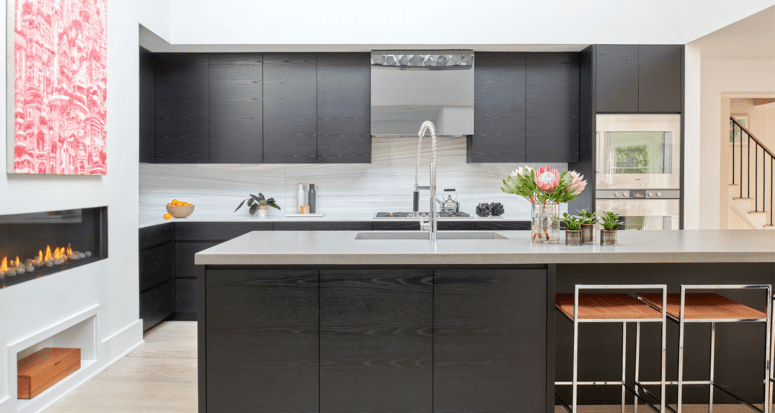From Fallout Shelters to Food Prep: Concrete Countertops Sly Slide in Design
- Published on
- 7 min read
-
 Gina Rodrigues Contributing AuthorClose
Gina Rodrigues Contributing AuthorClose Gina Rodrigues Contributing Author
Gina Rodrigues Contributing AuthorGina is a freelance writer and editor who specializes in real estate and personal finance. She brings more than ten years of experience as a licensed agent and property investor. When she isn’t writing, she can be found tending to the sheep and chickens at her suburban homestead outside of Seattle. Gina holds a B.A. in English from California State University.
Move over, marble. Concrete countertops are literally in the house.
Once relegated to utilitarian outdoor structural use — think fallout shelters and freeway pillars — this material has since crept its way into design lovers’ Instagram stories and Pinterest boards. And some seriously swoon-worthy homes.
Joanna Gaines flashes the look in her Texas farmhouse kitchen. Aaron Paul of “Breaking Bad” uses it to accent his European-inspired Idaho getaway. And Dr. McDreamy, “Grey’s Anatomy” star Patrick Dempsey, sports sleek grey concrete in his rustic, yet modern Malibu kitchen.
The concrete trend isn’t just for red carpet celebs. Sure, you’ll need a healthy budget for professionally installed concrete countertops. But if you’re willing to put in the sweat equity, you can cast your own concrete counters for a budget-friendly alternative to mainstream materials like granite and quartz.
While concrete has similar maintenance and durability traits as other natural stone material, concrete’s uniquely flexible design style sets the material apart from other countertop options.
Considering concrete counters for your home, but not sure if it’s right for you? To find out about the pros and cons of this trend-setting style, we caught up with concrete expert Paul Grech, Creative Director at Trueform Concrete. Grech gave us the inside scoop on what makes concrete the perfect countertop component — and when it’s best to pass on the trend.

Rising trend: Concrete becomes chic
There’s debate about whether the Egyptians or the Romans were the first to use concrete in large-scale building projects. Today, concrete is the most popular building material in the world. And in recent decades, it’s advanced beyond its longtime status as a ubiquitous structural material into the interior design sphere.
Early influencers
Grech credits concrete pioneers Buddy Rhodes and Fu-Tung Cheng as the earliest visionaries bringing concrete inside the home. In the 1980s, Rhodes and Cheng embraced concrete as an artistic design element instead of simply relegating it to a home’s structural underpinnings. Unlike slab rock countertops, concrete artisans could cast and mold the substance like clay, making it customizable to a specific purpose.
Rhodes and Cheng publicized the craft of concrete design by way of books, magazine articles, and tutorials. Concrete as a design element slowly gained a foothold in the design sphere. Since then, concrete has continued its slow climb as a high-end countertop material. The niche industry touts concrete as an artisan-made, built-to-spec alternative to mainstream materials such as granite and marble.
Modern-day design
One of the primary draws of concrete in interior design is the ability to customize it to a space. Concrete can be cast into “nearly limitless” forms, says Grech. The result: a countertop that complies with its designer’s every whim. Want an edge that’s seven inches thick? Done. Smooth curves instead of hard angles? You got it. Lime green tint to match the Andy Warhol painting in your living room? Not a problem.
In line with concrete’s clay-like ability to mold into a physical space, the material has an enigmatic style that suits nearly any design aesthetic. Concrete blends into a stone, wood, and plaster environment (as seen in Aaron Paul’s Idaho home) as seamlessly as it melds into a country kitchen replete with white Shaker cabinets and nickel cup pulls.
“We like to think of concrete as the chameleon of the design world,” says Grech.
Trendy yet unpretentious, concrete pulls off both old-world style and modern minimalism with aplomb. And despite its cold, dull reputation, concrete appears surprisingly warm when brought into the context of your home.

Concrete countertops for your home
If you’re considering concrete countertops, you’ll have a seemingly endless choice of design decisions. Its custom nature lends itself to design options that aren’t available with other materials. Similar to other stone countertops, concrete is durable but not maintenance-free. For some, the cost becomes the deciding factor when choosing whether to go for concrete or another material.
Finish and design options
With slab stone materials, you’re limited to what’s quarried and warehoused near your home. If you want something specific, you’ll have to hunt it down.
Concrete, on the other hand, is custom-made. It’s crafted to fit your space and designed to minimize seams. You can personalize any number of characteristics, from your countertop’s color to its inlaid decorative stones.
- Texture: Concrete can be sanded into a sleek, smooth surface or crafted for a rougher, irregular texture.
- Inlay: For a bespoke countertop, you can inlay any number of objects. Incorporate your favorite garden stones, imbed a metal design, or add seashells from your latest beach visit.
- Thickness: With concrete, you aren’t limited by pre-cut slabs. Fabricators can mold a countertop to your specifications. For a thick countertop, fabricators can mold a seamless, edged lip to make the stone appear taller without adding extra weight.
- Color: Instead of painting the surface, you can personalize your concrete counter by mixing in custom pigments. Using pigment rather than paint reduces fading.
Maintenance
Like other natural stone, concrete countertops require regular maintenance since it’s susceptible to scratches and stains. Sealing your concrete countertop can help prevent those minor imperfections brought about by daily use.
Concrete’s major downfall is porosity, says Grech. That’s why sealing is so important to protect against etching and staining. “If anyone tries to sell you on unsealed countertops — run for the hills,” he warns.
Grech suggests professional sealing every three to five years. The process includes sanding and sealing your countertop’s surface with a professional-grade topical sealant that creates a hard, impervious skin to protect against everyday use.
Concrete guru Cheng recommends a different maintenance schedule for do-it-yourselfers. He suggests applying a penetrating sealer that infuses into the concrete, along with monthly waxing with beeswax or carnauba wax. For a more intensive refresh, you can also polish the surface every five to ten years.
For daily maintenance, wipe spills quickly to avoid absorption and staining. Clean the surface with soap, a sponge, and a bit of elbow grease. Also, avoid abrasive cleaners, such as bleach, which could damage the sealer.
To keep your countertop in primo shape, chop your onions on cutting boards instead of directly on the counter to avoid scratches. And put your hot cast iron dish on a trivet, not directly onto your concrete countertop. While it won’t damage the concrete itself, the heat can damage and discolor your counter’s protective sealer.
Durability
Concrete as a building material is meant to withstand the test of time — and extreme environments. When properly cured, concrete can structurally resist high humidity, moisture, and even chemicals. That means a concrete countertop is more likely to outlive its aesthetic style than its functional use.
Despite concrete’s tough durability, concrete countertops are known to crack, stain, etch, and show scratches. Although some homeowners prefer their concrete countertops to have a natural, worn-in character, many want a sleek, polished finish. If you’re in the second camp, hire an experienced concrete fabricator to mitigate installation-related issues such as warping, bowing, and bubbling.
Sealing your countertop and quickly wiping up spills helps avoid staining. Still, concrete probably isn’t the best material for those rough on their countertops. If you use knives directly on the counter and often drop hot pans onto the surface, Grech suggests choosing a synthetic material, like quartz, instead.
While concrete can be deemed durable, it isn’t impervious to damage. You can repair concrete, such as chipped edges, with a color-matched chip repair kit. To resolve surface-level wear, you can also sand down the finish and reseal the surface.
Cost
When it comes to budgeting for your dream concrete countertops, your options sit at opposite ends of the spectrum. If you’re handy and up for a challenge, you can craft your own countertops at a budget-friendly price. But for professional-grade installation, get ready to pony up a pretty penny for this on-trend look.
DIY installation
Cost conscious? Mix up a batch of concrete and cast your own countertops. “If you’ve got the time, equipment, and patience to give it a shot — I say go for it!” encourages Grech.
You aren’t alone if you’re considering the attempt. One popular YouTube video on crafting your own concrete countertops has garnered more than 5.5 million views.
Just don’t expect Michelangelo-level results as a novice. You’ll have to juggle different factors. Building the mold, sourcing the right mix, figuring out how much water to use, mixing the right consistency, pouring the mix properly, and deciding on a curing protocol all affect the outcome. “Anyone can buy a sheet of cabinet-grade walnut from the lumber yard,” explains Grech. But “turning it into a functional art piece is a whole different ball game.”
Still, the cost savings could be worth it. Casting your own countertop will run you about $8 to $15 per square foot for materials, according to HomeAdvisor.
If you’re up for the challenge and don’t mind the pitfalls that accompany amateur installation — air bubbles, minor cracks, or multiple tries to get it right — DIY concrete countertops could be a relatively inexpensive path to the concrete design trend.
Professional installation
When professionally crafted, concrete countertops can easily outstrip the cost of granite and marble. According to Grech, professionally crafted concrete countertops start near $100 per square foot. HomeAdvisor estimates that a concrete kitchen countertop will set you back between $5,000 and $10,000. And those figures can be conservative. Custom design specs like gold veining and custom inlays drive up your final bill.
For cost comparison, HomeAdvisor estimates the cost of granite countertops between $2,000 and $4,500. Average marble countertops cost around $3,000, while high-end marble can run over $9,000.
Labor accounts for much of concrete’s cost due to its handmade nature. Contractors must mix, form, cure, and handle the material carefully to pull off installation. “Handle like glass!” warns Cheng to those who cast concrete off-site and carry the final pieces onto the job site.
Beyond labor, professional concrete countertop installation is expensive since most contractors use professional-grade materials — not $5 bags of concrete from Home Depot. According to Cheng, “ordinary premixed concrete bags” have inconsistent quality, leading to bumps and bubbles in the final product. Instead, most specialty contractors use high-quality, professional-grade materials. For example, Grech says that Trueform uses glass-fiber reinforced concrete (GFRC) for added strength to allow for thinner and lighter pieces than standard building-grade concrete.

Concrete countertops: Niche, not a mainstream solution
Because of its handmade, built-to-spec quality, concrete solves creative design problems that traditional materials can’t. It can fit into a specific space both functionally and creatively with custom styling. Just be prepared to save up for an experienced craftsman, unless you’re willing to do the work yourself.
“Concrete countertops may never actually end up as truly mainstream,” notes Grech. The fabrication process lends itself as a niche offering rather than an off-the-shelf solution. But if you’re looking for a unique, personalized countertop design in your home, “it’s always a conversation starter.”
Header Image Source: (Trueform Concrete)
